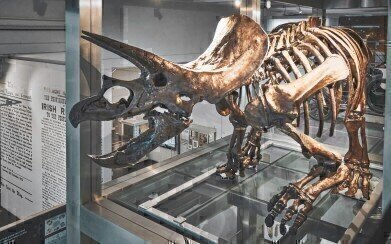News & views
Say Hello to the Regaliceratops!
Jun 21 2015
A decade-long excavation scheme has finally come to fruition in Calgary, Alberta, Canada, revealing a new species of dinosaur related to the triceratops. Unlike its cousin, regaliceratops has stunted horns above its eyes and a longer one protruding from over its nose (the triceratops has the inverse). It also has a more impressive shield around the back of its head, sometimes known as a frill.
The completion of the excavation comes just one year after the discovery of another new species of dinosaur in China. The specimen was named Yi qi, Chinese for “strange wing”, so-named for the gliding appendages which are reminiscent of those found on a bat.
A Labour of Love
The regaliceratops’ excavation was by no means an easy job, nor a quick one. The skull was actually spotted by chance in 2005 by a local geologist named Peter Hews. It was found protruding from a cliff face, which made it fairly inaccessible and difficult to reach to begin work. If that wasn’t bad enough, the rock that cemented the fossil in place also proved to be particularly durable, meaning that digging the skull out without damaging it was no mean feat.
The project was made even more complicated by the proximity of the nearby Oldman River, a protected fish-breeding habitat. To avoid debris and splintered rocks from falling into the protected waters, the team had to painstakingly build a damn to safeguard its purity.
Because of all of these hardships, the skull had already acquired the nickname “Hellboy” due to the hellish time it forced the archaeologists to endure in its excavation. When they noticed the diminutive bones sticking out over its eyes, the resemblance to the Hollywood character made the nickname take on a deeper significance, and the moniker stuck.
What’s in a Name?
Quite aside from the humorous nickname, the specimen was given the official name “Regaliceratops peterhewsi” for reasons twofold. The first part of the name refers to the regal, crown-like grandeur of the shield jutting out of the back of its head and guarding its neck. The second evidently refers to the man who first spotted it.
The fact that the regaliceratops shares the shield with triceratops but has contrasting horns is a symptom of an unusual evolutionary phenomenon known as convergent evolution. This is when separate species develop similar (but slightly different) characteristics as other species, over different periods of prehistory.
At 70 million years old, the regaliceratops is something of a spring chicken when it comes to horned dinosaurs. Its evolution and placement on the historical timeline is proof that horned and frilled dinosaurs were thriving when the asteroid which made them extinct crashed into the Earth, says University of Edinburgh palaeontologist Steve Brusatte.
“Because this new dinosaur is one of the latest surviving horned dinosaurs, living at a similar time as triceratops, it is also telling us that horned dinosaurs remained quite diverse right until the end,” Brusatte explained. “To me, this is a strong hint that these dinosaurs were at or near the top of their game when that asteroid fell out of the sky.”
Find out more and see the regaliceratops!
Digital Edition
Lab Asia 31.6 Dec 2024
December 2024
Chromatography Articles - Sustainable chromatography: Embracing software for greener methods Mass Spectrometry & Spectroscopy Articles - Solving industry challenges for phosphorus containi...
View all digital editions
Events
Jan 22 2025 Tokyo, Japan
Jan 22 2025 Birmingham, UK
Jan 25 2025 San Diego, CA, USA
Jan 27 2025 Dubai, UAE
Jan 29 2025 Tokyo, Japan



















